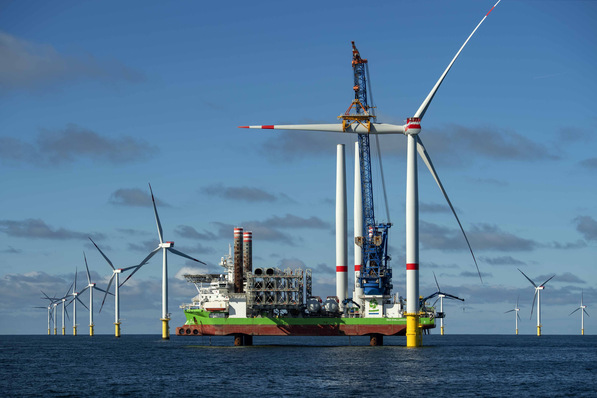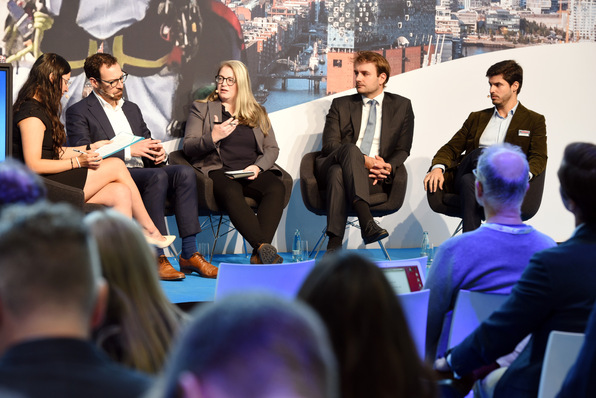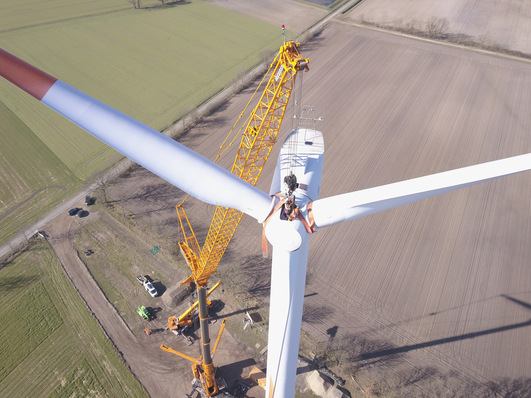Tilman Weber
Let´s once more talk about the impressive cost reduction of offshore wind power – your branch: Which of the following three is the main driver for cost reductions especially caused by improving the MHI Vestas technology? Is it the increase of installation speed per turbine? Is it the size of the V164 meaning reduction of trips to the ocean? Or is it the size of the rotor and caused by it an higher AEP?
Philippe Kavafyan: It is all of the mentioned. Besides of installation speed of course the increase of nominal capacity up to eight Megawatt is reducing the capex – while you have less foundations. In some cases we saw, that the capacity factor also is an important factor – not so for the Capex but for Opex. Today, there is so much diversity within the projects, so that we need to respond to customer´s individual requirements. The capacity factor offshore is depending on wind conditions and on the investment in grid connection, the cost of foundation is depending on the water depth. Today you have I would say more than before the need for a certain flexibility in delivering technical solutions and turbine types. The idea of one-feed-all-solution is becoming less and less adapted to the very competitive situation of our customer. Instead, which solution is good, is only depending on our customer´s strategy or if you go in a global environment on the condition of Taiwan or on the condition of the US or on the condition of the North Sea. What is needed in the North Sea is also depending on your grid connection in Germany or the offshore conditions in the UK – all these factors are driving the product optimization. So yes, the nominal capacity, less turbines to maintain, yes all of that prevail.
… and obviously also the increased installation speed for turbine …
Philippe Kavafyan: But any new modernized technology like at last V164 is requiring some time for adapting the tools, the process, the experience. And it took us several projects to be where our main competitor is with it´s installation speed and installation figures. And we now reached a point, from where we got into a constructive competition.
… with Siemens Gamesa. But of course the several phases of technological wind turbine development showed different advancements and innovations – and the one of them was having more effect then the other. Which advancement is in this year or will be in the next year the most decisive for your V164? As you showed by a graph at Windforce conference now, the increase of installation speed is nearly done … Would it need a bigger turbine for the next step?
Philippe Kavafyan: We think that on the current V164 platform, where we had been always very strong on nominal capacity, now the ratio of the rotor vs the generator is in the size where we need it. But we think that our first improvement in the nearer future is to increase the rotor and not as much the nominal capacity. So we improve the ratio of the swept area with the nominal capacity – the capacity factor!
That will happen soon?
Philippe Kavafyan: We are introducing the V174 – and as we do this, we are going to pay attention to that ratio. Because we basicly had the V164 with the eight Megawatt and we actually pushed the nominal capacity more than the ratio – the capacity factor. And therefore the V174 will establish a better ratio. And we have to work to stay a little bit centered in that draft. Just right now we tend to have a big generator behind a smaller rotor – if we compare the V164 with the other turbines to come, our competitor´s next turbines with 10 MW and more power. But now we think we need a step for our current platform to increase the rotor size. And when it gets to the larger nominal capacity of at least 10 MW and more, we see the announcements of our competitors. But it will take them some time to become their announcements a real product being certified …
Which announcements?
Philippe Kavafyan: I mean, GE was announcing it´s 12-MW-turbine, Siemens was announcing the ten-MW-turbine. The reality is even the first 167-metres-Rotor of Siemens Gamesa is not yet installed today. On the surface, it might look like we need something larger right away because Siemens Gamesa already announced the 10-MW-turbine with a rotor diameter of 193 meters, but they haven´t installed the first commercial project even with the SG-167. So there is a difference between them talking to the customers about projects four years from now and us talking once: Well, we are delivering a new 10-MW-machine today. So for us only the 200 machines installed by MHI Vestas save our credibility. Our company needs to recourse on delivering a large quantity of the existing product still and having a larger capacity in the existing supply chain to have the right repeatability and the right predictability that we believe is associated to finally be or become the number one in the industry.
You already mentioned the special competition with SGRE. So do you have a vision at which year you must present the next size for your offshore turbine – not only the size of rotor but also the size of capacity?
Philippe Kavafyan: Today – it is not that I don´t want to tell you – we don´t have officially decided when we go to the next size. The reason is, we see this balance between the next technology step and the effectiveness of installing V164 or the effectiveness to ramp up our V164 supply chain further. To further stick to V164 is a bit subcritical compared to the situation, if we immediately jump.
What do you mean by subcritical?
Philippe Kavafyan: That all the investment of the supply chain – not only ours but also the investments of the component suppliers – can benefit from more volume of the same machine. So, as long as we are incrementally building on this platform and we are for example evolving the turbine type with the rotor size, while remaining in the main envelope of the current platform - we can capitalize on the volume. We were comfortable to go into this same platform evolution – it is the same way now we took it from eight to ten MW as some people before took it from six to eight. You end up with more robust supply chain and the cost is going down with volume. Basicly, the situation is: We don’t have thousands of turbines and the offshore market is growing in Megawatt not so in number of units. To be aware of that means knowing, that everyone who is working with us don´t want constantly change things. Changes of technology and turbine platforms mean new cost of tooling, of validation – even if you only upgrade the drive train. The positive aspect of having a gearbox like we have it in the V164 is: It gives us flexibility. It is true, that we are going to play with that because we see the continuous improvement of our nominal capacity. We try to do it in a way as much as possible by not generating too much a redesign and a revalidation. The timing – to finally answer your question about when to do the next step is needed: We really expect that in the mid twenties to happen.
It´s a long time by then …
Philippe Kavafyan: Everything we do takes three to four years. So the answer is: not really. When I´m talking about the real installations – the prototype will come sooner –, if you ask me, when the new turbine is on the market, the answer is as said before. People – customers – already talk to me about the 174 and they feel like it´s a small turbine compared to the plans of our competitors. But our competitors One-Hundred-Eighty or One-Hundred-Ninety are not running, yet. For V164 we are still in that space of industrial scale project installation. So before we say 174 is too small we want to install some and then yes we need to consider the right steps. But in the design phase if you need to consider the full dimension of the series including the construction, including the maintenance, you want to do really the most you can for to simplify and limit the new turbine type as an offshore machine. But we also need to simplify the work, we need to simplify the work in every step. Look at the installation process: We need to simplify the work not just offshore but also in the preassembly. And we have to reduce production effort. So it is a full optimization process. So, when you choose technology you want to make sure, that the next turbine is bigger – but on the other hand it doesn´t take more time to manufacture, to preassemble and to install it.
Where will the production sites of your machines be sited in the future? Could you really keep being the Europe-centered industrial player MHI Vestas?
Philippe Kavafyan: Something has changed in the strategy over the last 18 months for us. Of course we announce the product, we build the pipeline of projects in Europe and in the UK … But we at the same time already have projects in Taiwan. Japan is becoming now closer and closer to investment decision on projects. Our people were in South Korea, we see Vietnam, a lot is happening in China. But for us it is not considerable to ship for a long time components to Asia. Even from the beginning it is not sustainable to use your manufacturing footprint in Europe for to serve not only the European region that is growing a lot in volume: UK grows in volume, Belgium, Netherlands, Germany will come back, I am optimistic, Poland will come. We are not talking about a region that is closing the market. It is a booming market. ….
So you don´t need other world regions like Asia, to use your European productions sites to the full?
Philippe Kavafyan: … At the same time we see in Asia a significant potential – it´s going to be a significant region which provides the fastest growth in the second half of the twenties. So localizing in Asia is important, too. Where shall we open our plants there? We hear South Korea wants localization, Taiwan has become very public with it´s claim for localization. But one can hardly imagine that we will have a regional industrial footprint country by country. We think, we will have an industrial footprint in Asia and we will have it in Europe and we will have it in the U.S.. In the U.S. right now we have auctions in different states and every state is following it´s own tendering process and it´s own plan. But I would say: MHI Vestas is completely subscribed to the idea, that U.S. offshore will be competitive when we will have local supply chain and we will have the logistics organized in a competitive way. We see this transition is needed and it will come. But we don´t see an economic model for any multiple footprint in the US. And it will be the same way in Europe: Even though to the Brexit discussion we consider our northern Europe base is well complemented with some more local content in the UK. We have already our blade production there. Production of towers, blades and some elements of the power electronics make totally sense to be localized in the respective region. And for the nacelle it will probably be similar. It is depending on the demand, but we expect to duplicade or triplicate the nacelle plan.







